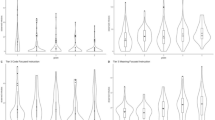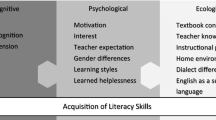Abstract
The purpose of this article is to provide the reader with a conceptual understanding of the key elements in a three tiered Response to Intervention (RTI) model. The three tiered model is discussed in terms of how it would be applied in implementing an intervention program to promote the development of reading. The characteristics of interventions, criteria for determining the delivery of services and the role of the school psychologist at each stage are discussed. The article concludes that RTI models are excellent approaches for designing intervention programs and school psychologists have a key role to play in helping to design and implement such programs. Concerns regarding the implementation of such models are noted.
Similar content being viewed by others
References
Adams, M. (1990). Beginning to read: Thinking and learning about print. London, England: MIT Press.
Al Otaiba, S., & Fuchs, D. (2002). Characteristics of children who are unresponsive to early literacy instruction: A review of the literature. Remedial and Special Education, 23(5), 300–316.
Berninger, V. (1998). Guides for intervention: Reading and writing. San Antonio, TX: The Psychological Corporation.
Bereiter, C., Brown, A., Campione, J., Carruthers, I., Case, R., & Hirshberg, J., et al. (2002). Open Court reading. Columbus, OH: SRA/McGraw-Hill.
Blachman, B., Schatschneider, C., Fletcher, F., & Clonan, S. (2003). Early reading intervention: A classroom prevention study and a remediation study. In B. Foorman (Ed.), Preventing and remediating reading difficulties: Bringing science to scale (pp. 253–274). Baltimore, MD: York Press.
Bowers, P., & Wolf, M. (1999). The “double-deficit hypothesis” for the developmental dyslexias. Journal of Educational Psychology, 9(1), 1–24.
Bradley, R., Danielson, L., & Hallahan, D. (Eds.). (2002). Identification of learning disabilities: Research to practice. Mahwah, NJ: Lawrence Erlbaum.
California Association of School Psychologists. (2003). Critical constructs and principles regarding the reauthorization of IDEA. Retrieved October 22, 2004, from www.caspsurveys.org?NEW/CASP_IDEAfinal.htm
Christo, C., Brady, J., & Leaman, S. (2003, Spring). The important role of school psychologists in current educational reforms. CASP Today, 1–3.
Deno, S., Fuchs, L., Marston, D., & Shin, M. (2001). Using curriculum-based measurement to establish growth standards for students with learning disabilities. School Psychology Review, 30(4), 507–524.
Denton, C., & Mathes, P. (2003). Intervention for struggling readers: Possibilities and challenges. In B. Foorman (Ed.), Preventing and remediating reading difficulties: Bringing science to scale (pp. 229–252). Baltimore, MD: York Press.
Donovan, M. S., & Cross, C.T. (2002). Minority students in special and gifted education. Washington, D.C.: National Academy Press. Retrieved January 2, 2005, from http://www.nap.edu/catalog/10128.html
Ehri, L. (2004). Teaching phonemic awareness and phonics: An explanation of the National Reading Panel meta-analysis. In P. McArdle & V. Chhabra (Eds.), The voice of evidence in reading research (pp. 153–186). Baltimore, MD: Paul Brookes.
Finn, C., Rotherman, A., & Hokanson, C. (Eds.). (2001). Rethinking special education for a new century. Washington, D.C.: Thomas B. Fordham Foundation and Progressive Policy Institute.
Fletcher, J., Coulter, W., Reschly, D., & Vaughn, S. (2002). Alternative approaches to the identification of learning disabilities: Some questions and answers. Annals of Dyslexia, 52, 30–69.
Foorman, B. (Ed.). (2003). Preventing and remediating reading difficulties: Bringing science to scale. Baltimore, MD: York Press.
Fletcher, J., Shaywitz, D., Katz, L., Liberman, I., Stuebing, K., Francis, D. et al. (2002). Cognitive profiles of reading disability: Comparisons of discrepancy and low achievement definitions. Journal of Educational Psychology, 86, 6–23.
Fuchs, L. (2003). Assessing intervention responsiveness: Conceptual and technical issues. Learning Disabilities Research and Practice, 18(3), 172–186.
Fuchs, L., & Fuchs, D. (1999). Monitoring student progress toward the development of reading competence: A review of three forms of classroom-based assessment. School Psychology Review, 28(4), 659–671.
Fuchs, L., & Fuchs, D. (2002) Progress monitoring, accountability and LD identification. Testimony to the President’s Commission on Excellence in Special Education. Retrieved December 5, 2004, from http://www.aimsweb.com/_lib/pdfs/Lynn%20F%20Commission.pdf
Fuchs, D., Fuchs, L., Mathes, P., Lipsey, M., & Eaton, S. (2000). A meta-analysis of reading differences between underachievers with and without the LD label: A brief report. Learning Disabilities: A Multidisciplinary Journal, 10(1), 1–4.
Gaskin, J., Ehri, L., Cress, C., & Donnelly, K. (1997). Procedures for word learning: Making discoveries about words. The Reading Teacher, 50, 312–327.
Good, R., Simmons, D., & Kame’enui, E. (2001). The importance and decision making utility of a continuum of fluency-based indicators of foundational reading skills for third-grade high-stakes outcomes. Scientific Studies of Reading, 5(3), 257–288.
Gresham, F. (2001). Responsiveness to intervention: An alternative approach to the identification of learning disabilities. Paper presented at the Learning Disabilities Summit: Building a Foundation for the Future, Washington, D.C.
Individuals With Disabilities Education Improvement Act of 2004, 20 U.S.C. 1400 et seq.
Houghton-Mifflin. (2001). Houghton-Mifflin reading: A legacy of literacy. Boston, MA: Author.
Iverson, S., & Tunmer, W. (1993). Phonological processing skills and the Reading Recovery program. Journal of Educational Psychology, 85, 112–136.
Kaminski, R., & Good, R. (1998). Assessing early literacy skills in a problem solving model: Dynamic indicators of basic early literacy skills. In M. Shinn (Ed.), Advanced applications of curriculum based measurement (pp. 113–142). New York: Guilford.
Kovaleski, J. (2003). The three tier model for identifying learning disabilities: Critical program features and systems issues. Paper presented at the Response to Intervention Symposium, Kansas City, MO.
Kratochwill, T., & Stroiber, K. (2000). Uncovering critical research agendas for school psychology: Critical dimensions and future directions. School Psychology Review, 29(4), 591–603.
Kratochwill, T., & Shernoff, E. (2004). Evidence-based practice: Promoting evidence-based interventions in school psychology. School Psychology Review, 33(1), 34–48.
Lyon, R., Fletcher, J., Shaywitz, S., Shaywitz, B., Torgesen, J., Wood, F. et al. (2001). Rethinking learning disabilities. In C. Finn, A. Rotherman, & C. Hokanson (Eds.), Rethinking special education for a new century (pp. 259–287). Washington, D.C.: The Fordham Foundation.
Mastropieri, M. (2003). Feasibility and consequences of response to intervention (RTI): Examination of the issues and scientific evidence as a model for the identification of individuals with learning disabilities. Paper presented at the Responsiveness to Intervention Symposium, Kansas City, MO.
Mathes, P., & Torgesen J. (1998). All children can learn to read: Critical care for the prevention of reading failure. Peabody Journal of Education, 73(34), 317–340.
National Reading Panel. (2000). Report of the National Reading Panel. Teaching children to read: An evidence-based assessment of the scientific literature on reading and its implications for reading instruction: Reports of the subgroups. Unpublished manuscript, Washington, D.C.
National Research Council. (2002). Minority students in special and gifted education. Paper presented at the Committee on Minority Representation in Special Education, Washington, D.C.
No Child Left Behind Act of 2001, 20 U.S.C. 6300 et seq.
Presidents Commission on Excellence in Special Education. (2002). A new era: Revitalizing special education. Washington, D.C.: U.S. Department of Education. Retrieved January 3, 2003, from http://www.ed.gov/inits/ommissionsboards/whspecialeducation/reports.html
Rayner, K., Foorman, B., Perfetti, C., Pesetsky, D., & Seidenberg, M. (2001). How psychological science informs the teaching of reading. Psychological Sciences in the Public Interest, 2, 31–73.
Shapiro, E. (2004). Academic skills problems: Direct assessment and intervention. New York: Guilford.
Shaywitz, S. (2003). Overcoming dyslexia. New York: Alfred Knopf.
Shefelbine, J. (1999). Beginning Phonics Skills Test.
Shinn. (n.d.). Assessing response to intervention: Getting it right with the AIMSweb system. Retrieved December 27, 2004, from http://www.aimsweb.com/_lib/pdfs/AIMSweb%20RTI.pdf
Shinn, M., Shinn, M., Hamilton, C., & Clarke, B. (2003). Using curriculum based measurement in general education classrooms to promote reading success. In M. Shinn, H. Walker, & G. Stoner (Eds.), Interventions for academic and behavior problems II: Preventive and remedial approaches (pp. 113–142). Bethesda, MD: National Association of School Psychologists.
Simmons, D., Kame’uni, E., Good, R., Harn, B., Cole, C., & Braun, D. (2002). Building, implementing and sustaining a beginning reading improvement model: Lessons learned school by school. In M. Shinn, H. Walker, & G. Stoner (Eds.), Interventions for academic and behavior problems II: Preventive and remedial approaches (pp. 537–570). Bethesda, MD: National Association of School Psychologists.
Stage, S., & Jacobson, M. (2002). Predicting student success on a state-mandated performance-based assessment. School Psychology Review, 31(1), 71–92.
Stanovich, K., & Siegel, L. (1994). Phenotypic performance profile of children with reading disabilities: A regression-based test of phonological-core variable-difference model. Journal of Educational Psychology, 86, 24–53.
Strong, K., Christo, C., & Cooley, L. (2003) School-wide change and the role of the school psychologist: A three-point system for increasing school success for all students. Paper presented at the California Association of School Psychologists Annual Meeting, Los Angeles, CA.
Swanson, L. (1999). Instructional components that predict treatment outcomes for students with learning disabilities: Support for a combined strategy and direct instruction model. Learning Disabilities Research and Practice, 14, 129–141.
Swanson, H., Hoskyn, M., & Lee, C. (1999). Interventions for students with learning disabilities: A meta-analysis of treatment outcomes. New York: Guilford.
Torgesen, J. (2000). Individual differences in response to early intervention: The lingering problem of treatment resistors. Learning Disabilities Research and Practice, 15, 55–64.
Torgesen, J. (2004). Lessons learned from research on interventions for students who have difficulty learning to read. In P. C. McCardle (Ed.), The voice of evidence in reading research (pp. 355–382). Baltimore, MD: Paul Brooks.
Torgesen, J., Alexander, A., Wagner, R., Rashotte, C., Voeller, K., & Conway, T. (2001). Intensive remedial instruction for children with severe reading disabilities: Immediate and long-term outcomes from two instructional approaches. Journal of Learning Disabilities, 34, 33–58.
Tunmer, W., Chapman, J., & Prochnow, J. (2003). Preventing negative matthew effects in at-risk readers. In B. Foorman (Ed.), Preventing and remediating reading difficulties: Bringing science to scale (pp. 122–164). Baltimore, MD: York Press.
United States Department of Education. (2002). No child left behind: Elementary and secondary education act. Washington, D.C.: Author.
Vaughn, S., & Fuchs, L. (2003). Redefining learning disabilities as inadequate response to intervention: The promise and potential problems. Learning Disabilities Research and Practice, 18(3), 137–146.
Vaughn S., & Linan-Thompson, S. (2003). Group size and time allotted to intervention. In B. Foorman (Ed.), Preventing and remediating reading difficulties: Bringing science to scale (pp. 299–324). Baltimore, MD: York Press.
Vellutino, F., & Scanlon, D. (1996). Cognitive profiles of difficult-to-remediate and readily remediated poor readers. Journal of Educational Psychology, 88(4), 601–639.
Wolf, M., Bowers, P., & Biddle, K. (2000). Naming speed processes, timing and reading: A conceptual review. Journal of Learning Disabilities, 33, 387–407.
Author information
Authors and Affiliations
Corresponding author
Rights and permissions
About this article
Cite this article
Christo, C. Critical Characteristics of a Three Tiered Model Applied to Reading Interventions. Contemp School Psychol 10, 33–44 (2005). https://doi.org/10.1007/BF03340919
Published:
Issue Date:
DOI: https://doi.org/10.1007/BF03340919




